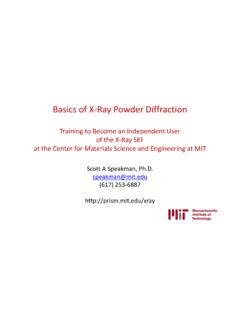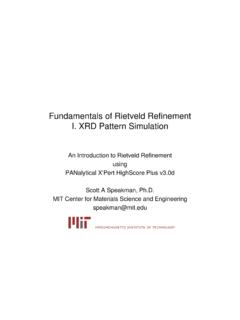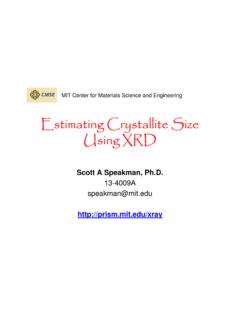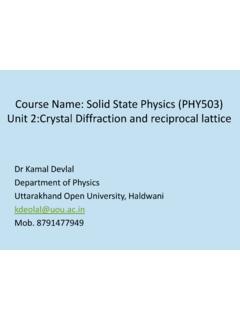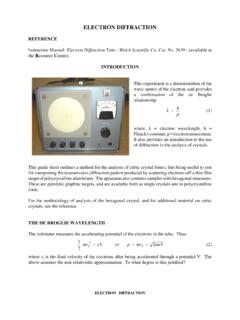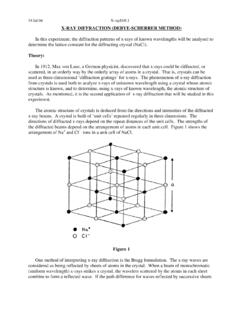Transcription of Introduction to XRPD Data Analysis
1 Introduction toX-Ray Powder DiffractionData AnalysisScott A Speakman, for Materials Science and Engineering at X-ray diffraction pattern is a plot of the intensity of x -rays scattered at different angles by a sample The detector moves in a circle around the sample The detector position is recorded as the angle 2theta (2 ) The detector records the number of x -rays observed at each angle 2 The X-ray intensity is usually recorded as counts or as counts per second To keep the X-ray beam properly focused, the sample will also rotate. On some instruments, the X-ray tube may rotate instead of the # of 20 Scott A Speakman, 2 2 2 2 X-ray tubesamplePosition [ 2 Theta] (Cu K-alpha)3540455055 Intensity (Counts)0500010000 Each phase produces a unique diffraction pattern A phase is a specific chemistry and atomic arrangement.
2 Quartz, cristobalite, and glass are all different phases of SiO2 They are chemically identical, but the atoms are arranged differently. As shown, the X-ray diffraction pattern is distinct for each different phase. Amorphous materials, like glass, do not produce sharp diffraction # of 20 Scott A Speakman, [ 2 Theta] (Cu K-alpha)152025303540 QuartzCristobaliteGlassThe X-ray diffraction pattern is a fingerprint that lets you figure out what is in your sample. The diffraction pattern of a mixture is a simple sum of the diffraction patterns of each individual phase. From the XRD pattern you can determine: What crystalline phases are in a mixture How much of each crystalline phase is in the mixture (quantitative phase Analysis , QPA, is covered in another tutorial) If any amorphous material is present in the mixtureSlide # of 20 Scott A Speakman, [ 2 Theta] (Cu K-alpha)152025303540 QuartzCristobaliteGlassPosition [ 2 Theta] (Copper (Cu))
3 1520253035400 MixtureQualitative Analysis of XRD DataSlide # of 20 Scott A Speakman, XRD data are compared to reference patterns to determine what phases are present The reference patterns are represented by sticks The position and intensity of the reference sticks should match the data A small amount of mismatch in peak position and intensity is acceptable experimental errorSlide # of 20 Scott A Speakman, Displacement Error will cause a small amount of error in peak positions Specimen displacement is a systematicpeak position error due to misalignment of the sample. The direction and amount of peak shift will vary as Slide # of 20 Scott A Speakman, that are close together should be shifted the same direction and by the same amount The peak shift follows a cos behavior, so peak shift might change direction over a large angular rangeMost diffraction data contain K-alpha1 and K-alpha2 peak doublets rather than just single peaks The k-alpha1 and k-alpha2 peak doublets are further apart at higher angles 2theta The k-alpha1 peaks always as twice the intensity of the k-alpha2 At low angles 2theta, you might not observe a distinct second peakSlide # of 20 Scott A Speakman, experimental data should contain all major peaks listed in the reference patternSlide # of 20 Scott A Speakman.
4 A major reference peak is not observed in the data, then that is not a good matchMinor reference peaks could be lost in the background noise, so it may be acceptable if they are not observedThis is an example of a bad match between the data and the reference patternThe X-ray diffraction pattern is a sum of the diffraction patterns produced by each phase in a mixtureSlide # of 20 Scott A Speakman, [ 2 Theta] (Copper (Cu))2530354045 Counts040016003600 Rutile, syn; Rutile, syn; Rutile, syn; Rutile, syn; Rutile, syn; Hematite, syn; Hematite, syn; Hematite, syn; Hematite, syn; Hematite, syn; Hematite, syn; Anatase, syn; Anatase, syn; Anatase, syn; Anatase, syn; Each different phase produces a different combination of peaks. You cannot guess the relative amounts of phases based upon the relative intensities of the diffraction peaks The pattern shown above contains equal amounts of TiO2and Al2O3 The TiO2pattern is more intense because TiO2diffracts X-rays more efficientlySlide # of 20 Scott A Speakman, proper calibration, you can calculate the amount of each phase present in the sampleDiffraction peak broadening may contain information about the sample microstructure Peak broadening may indicate.
5 Smaller crystallite size in nanocrystalline materials More stacking faults, microstrain, and other defects in the crystal structure An inhomogeneous composition in a solid solution or alloy However, different instrument configurations can change the peak width, tooSlide # of 20 Scott A Speakman, patterns show the difference between bulk ceria (blue)and nanocrystalline ceria (red)These patterns show the difference between the exact same sample run on two different instruments. When evaluating peak broadening, the instrument profile must be considered. Quantitative Analysis of XRD DataSlide # of 20 Scott A Speakman, peak positions can be used to calculated unit cell dimensions The unit cell dimensions can be correlated to interatomic distances Anything the changes interatomic distances- temperature, subsitutional doping, stress- will be reflected by a change in peak positionsSlide # of 20 Scott A Speakman, [ 2 Theta] (Copper (Cu)) degd= degd= To calculate unit cell lattice parameters from the diffraction peak positions Convert the observed peak positions, 2theta, into dhklvalues using Bragg s Law.
6 Determine the Miller indices (hkl) of the diffraction peaks from the published reference pattern If you do not have access to a reference pattern that identifies (hkl) then you will need to index the pattern to determine the (hkl) Use the d*2equation to calculate the lattice parameters Most Analysis programs contain an unit cell refinement algorithm for numerically solving the lattice parameters These programs can also calculate and correct for peak position error due to specimen displacementSlide # of 20 Scott A Speakman, = 2sin *cos**2*cos**2*cos**2**2222222 cklbchlabhkaclbkahdhkl+++++=The diffraction peak width may contain microstructural information Nanocrystallite size will produce peak broadening that can be quantified Once the crystallite size is larger than a maximum limit, the peak broadening cannot be quantified.
7 This creates an upper limit to the crystallite size that can be calculated. The upper limit depends on the resolution of the diffractometer. Non-uniform lattice strain and defects will also cause peak broadening Careful evaluation is required to separate all of the different potential causes of peak broadeningSlide # of 20 Scott A Speakman, [ 2 Theta] (Copper (Cu))23242526 Counts05001000 Width= radXS> 90 nmWidth= radXS ~ 19 nmSize = The weight fraction of each phase can be calculated if the calibration constant is known The calibration constants can be determined: By empirical measurements from known standards By calculating them from published reference intensity ratio (RIR) values By calculating them with Rietveld refinementSlide # of 20 Scott A Speakman, [ 2 Theta] (Copper (Cu))2530354045 Counts040016003600 TiO2, Rutile %Fe2O3, Hematite %TiO2, Anatase %All calculations are more accurate if you use more peaks over a longer angular range If you use one or two peaks, you must assume: That there is no specimen displacement error when calculating lattice parameters That there is no microstrain broadening when calculating crystallite size If you use many peaks over a long angular range (for example, 7+ peaks over a 60 2theta range), you can.
8 Calculate and correct for specimen displacement when solving lattice parameters Calculate and account for microstrain broadening when calculating crystallite size Improve precision by one or two orders of magnitudeSlide # of 20 Scott A Speakman, are different ways to extract peak information for quantitative Analysis Numerical methods reduce the diffraction data to a list of discrete diffraction peaks The peak list records the position, intensity, width and shape of each diffraction peak Calculations must be executed based on the peak list to produce information about the sample Full pattern fitting methods refine a model of the sample A diffraction pattern is calculated from a model The calculated and experimental diffraction patterns are compared The model is refined until the differences between the observed and calculated patterns are minimized.
9 The Rietveld, LeBail, and Pawley fitting methods use different models to produce the calculated patternSlide # of 20 Scott A Speakman, peak list for empirical Analysis can be generated in different ways The diffraction data are reduced to a list of diffraction peaks Peak search Analysis of the second derivative of diffraction data is used to identify likely diffraction peaks Peak information is extracted by fitting a parabola around a minimum in the second derivative This method is fast but the peak information lacks precision Profile fitting Each diffraction peak is fit independently with an equation The sum of the profile fits recreates the experimental data Peak information is extracted from the profile fit equation This method provides the most precise peak informationSlide # of 20 Scott A Speakman, (deg.)
10 Intensity ( )Profile Fitting produces precise peak positions, widths, heights, and areas with statistically valid estimates Empirically fit experimental data with a series of equations fit the diffraction peak using the profile function The profile function models the mixture of Gaussian and Lorentzian shapes that are typical of diffraction data fit background, usually as a polynomial function this helps to separate intensity in peak tails from background To extract information, operate explicitly on the equation rather than numerically on the raw dataSlide # of 20 Scott A Speakman, peak lists are best reported using dhkland relative intensity rather than 2 and absolute intensity. The peak position as 2 depends on instrumental characteristics such as wavelength.


